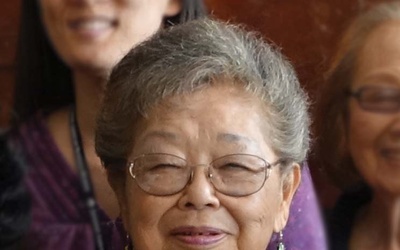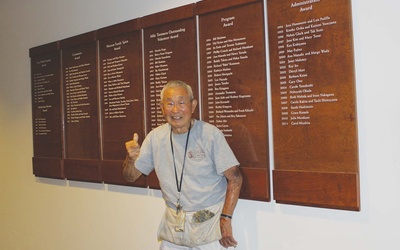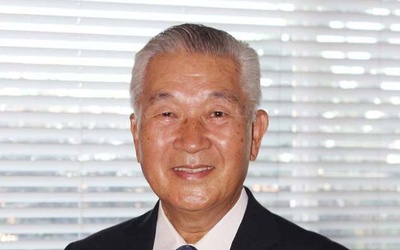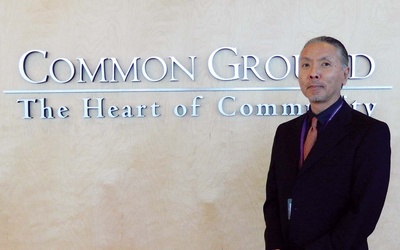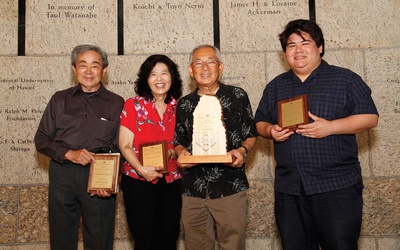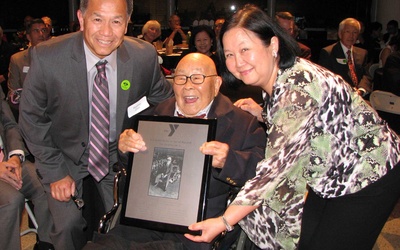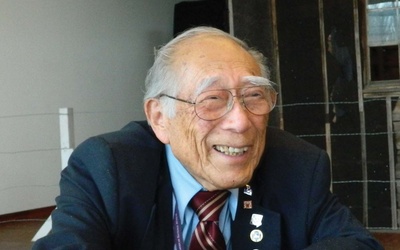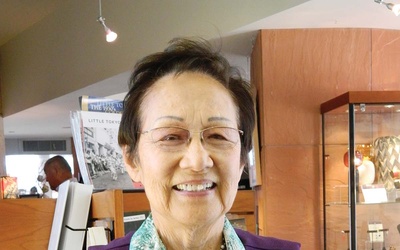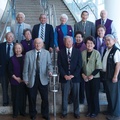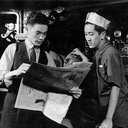
The Rafu Shimpo
@rafushimpoThe Rafu Shimpo is the premier newspaper of the Japanese American community. Since 1903, it has provided bilingual coverage and analysis of Nikkei news in Los Angeles and beyond. Visit the Rafu Shimpo website to read articles and to explore subscription options for print and online news.
Updated September 2015
Stories from This Author
Mary Karatsu
March 14, 2016 • The Rafu Shimpo
“After I retired in 1993 as assistant to the president of a large nonprofit organization, I began my second career as a volunteer,” says Mary Karatsu. Indeed, she has been a prominent figure among community-based organizations like the Japanese American National Museum for many years, armed with determination and no small amount of charm. Her early inspiration came from a Caucasian lady who took her under her wing and taught her what it meant to serve others. “She was such …
Robert “Bob” Uragami
Feb. 22, 2016 • The Rafu Shimpo
“I am not a museum type of person,” says Bob Uragami. He had his first encounter with the Japanese American National Museum in 1991 when it was looking for artifacts for its first exhibition, Issei Pioneers: Hawaii and the Mainland, 1885–1924. Bob submitted a Japanese letter, dated about 1916, which had belonged to his mother. The museum translated it for him. It was a letter from his father, who was living in the U.S., to his future bride. “Contrary to what …
Kihachiro Tajima
Feb. 8, 2016 • The Rafu Shimpo
Kimio Tajima was an American-born Nisei, but he died a Japanese soldier, while at war in New Guinea. He was 28 years old. His son, Kihachiro, was only ten months old when Kimio was drafted. Kihachiro grew up being called a war orphan, not remembering his father’s face. When he was in elementary school, he asked his mother, “Why am I a war orphan?” She told him, “Your father died in war as a Japanese soldier, but he was born …
Nahan Gluck
Jan. 25, 2016 • The Rafu Shimpo
As a volunteer docent at the Japanese American National Museum, Nahan Gluck leads his tours with pride, compassion, and conviction. What many find surprising, and maybe a bit refreshing is that this particular docent does not have an ounce of Japanese in him, biologically that is. Born in New York, Nahan moved to California when he was six years old. One accidental encounter in the 1950s changed his life in ways he could never have imagined, he befriended Kazuto Hirata, …
Nao Magami
Jan. 11, 2016 • The Rafu Shimpo
When Tokyo native Nao Magami was a student at California State University in the 1970s, he wondered why his Japanese American friends only spoke English, unlike the Chinese and Korean American students, many of whom spoke their parents’ languages. One day in an Asian American studies class, he watched a film, Farewell to Manzanar, which depicted the internment experience of Japanese Americans. After watching it, he felt like he understood the reason for the first time. More than 30 years …
Kyle Honma
Dec. 28, 2015 • The Rafu Shimpo
Kyle Honma is a volunteer of the Hirasaki National Resource Center at the Japanese American National Museum. He started volunteering at the museum because of the influence of his paternal grandparents Hideo and June. They had volunteered for 16 years since the commencement of the Museum. Kyle is a Japanese American Yonsei and a fourth generation Mexican American. It was 1997 when he first visited the Japanese American National Museum with his grandparents. He was in the first grade at …
YMCA And JA Community Leader Fred Hoshiyama Passes At 100
Dec. 22, 2015 • The Rafu Shimpo
Fred Yaichio Hoshiyama, a hero and a legend to both the YMCA and the Japanese American community, passed away on November 30, 2015 in Los Angeles, just one week shy of his 101st birthday. A year ago, about 150 friends, relatives, and associates of Hoshiyama celebrated his 100th birthday at the Japanese American National Museum in Little Tokyo. “They say that the first century is the hardest, so I’m looking forward to my second century… I hope to see you …
Hitoshi Sameshima
Dec. 14, 2015 • The Rafu Shimpo
Hitoshi Sameshima was born in Pasadena in 1921 to parents from Kagoshima, Japan. He was a junior at the University of Southern California when the war broke out in 1941. During WWII, his bilingual skills forced him into an uncomfortable position between Japan and the U.S. By 1942, he and his family were incarcerated at Gila River. He was drafted into the U.S. Army in 1944. Upon joining the Military Intelligence Service, which mainly consisted of Nisei linguists, Hitoshi was …
Yae Kanogawa Aihara
Nov. 30, 2015 • The Rafu Shimpo
Of all the Japanese-speaking docents at the Japanese American National Museum today, Yae Kanogawa Aihara is the last and only Nisei of the group who experienced the concentration camps during WWII. The rest were born and grew up in Japan, or Kibei who learned the language while growing up there. Yae started to learn her Japanese as a child and continued to learn it in Texas during WWII. Born in Tacoma, Washington, Yae was 16 when the war began. Her …
Masako Iwawaki Murakami
Nov. 16, 2015 • The Rafu Shimpo
Masako Iwawaki Murakami’s parents seldom talked about the years the family spent in an American concentration camp during WWII. Masako was 8 years old at the time and remembers how earnestly her mother and father tried to maintain a sense of normalcy for their children in spite of the extraordinary circumstances brought on by the Japanese attack on Pearl Harbor. One day recently, Masako came across a letter her mother had written to a friend at another concentration camp in …

